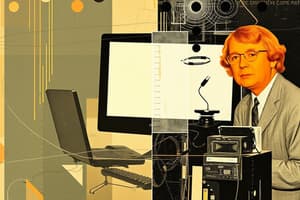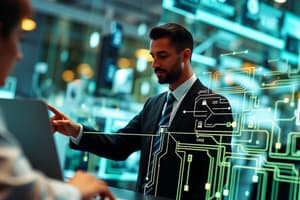Podcast
Questions and Answers
Which of the following computers was NOT a part of the First Generation of computers?
Which of the following computers was NOT a part of the First Generation of computers?
- EDVAC
- UNIVAC
- IBM (correct)
- ENIAC
What was the main characteristic of the software used in First Generation computers?
What was the main characteristic of the software used in First Generation computers?
- Object-oriented programming
- Machine language using 0s and 1s (correct)
- Graphical user interfaces
- High-level programming languages
What was a major drawback of First Generation computers?
What was a major drawback of First Generation computers?
- They were too expensive (correct)
- They were too small
- They were too slow
- They were too reliable
Which of the following was NOT a hardware technology associated with the First Generation of computers?
Which of the following was NOT a hardware technology associated with the First Generation of computers?
What was the typical processing speed of First Generation computers?
What was the typical processing speed of First Generation computers?
What was the primary function of punch cards in early computers?
What was the primary function of punch cards in early computers?
Which generation of computers is characterized by the use of transistors?
Which generation of computers is characterized by the use of transistors?
What company introduced the first commercially viable electronic digital computer, UNIVAC?
What company introduced the first commercially viable electronic digital computer, UNIVAC?
Which of the following computer models is NOT associated with the first generation of computers?
Which of the following computer models is NOT associated with the first generation of computers?
Which generation of computers saw the introduction of integrated circuits?
Which generation of computers saw the introduction of integrated circuits?
What was the name of the first microprocessor introduced by Intel Corporation?
What was the name of the first microprocessor introduced by Intel Corporation?
Which company's IBM PC (Personal Computer) significantly influenced the development of microcomputers in the 1980s?
Which company's IBM PC (Personal Computer) significantly influenced the development of microcomputers in the 1980s?
Which of the following is NOT considered a major player in the computer industry during the second generation, collectively known as BUNCH?
Which of the following is NOT considered a major player in the computer industry during the second generation, collectively known as BUNCH?
What is the main difference between a microcomputer and a minicomputer?
What is the main difference between a microcomputer and a minicomputer?
Which of the following is NOT a characteristic of a mainframe computer?
Which of the following is NOT a characteristic of a mainframe computer?
What is the main advantage of a supercomputer over a mainframe?
What is the main advantage of a supercomputer over a mainframe?
According to the passage, what is the main factor that determines the 'capacity' of a computer?
According to the passage, what is the main factor that determines the 'capacity' of a computer?
What is a 'microprocessor' as it relates to computers?
What is a 'microprocessor' as it relates to computers?
What is the primary function of a 'server' in a computer network?
What is the primary function of a 'server' in a computer network?
What is the main difference between 'ROM' and 'RAM' in the context of a computer?
What is the main difference between 'ROM' and 'RAM' in the context of a computer?
What type of computer would be most suitable for a large organization like a bank that needs to process millions of transactions daily?
What type of computer would be most suitable for a large organization like a bank that needs to process millions of transactions daily?
Flashcards
First Generation Computers
First Generation Computers
Computers from 1940-1956, characterized by vacuum tubes and bulky designs.
Vacuum Tubes
Vacuum Tubes
Electronic components used in first generation computers for processing and memory.
ENIAC
ENIAC
The first general-purpose electronic computer, used primarily for scientific calculations.
Machine Language
Machine Language
Signup and view all the flashcards
Millisecond Processing Speed
Millisecond Processing Speed
Signup and view all the flashcards
Capacity in Computing
Capacity in Computing
Signup and view all the flashcards
Microcomputers
Microcomputers
Signup and view all the flashcards
Minicomputers
Minicomputers
Signup and view all the flashcards
Mainframes
Mainframes
Signup and view all the flashcards
Supercomputers
Supercomputers
Signup and view all the flashcards
Peripheral Devices
Peripheral Devices
Signup and view all the flashcards
Random Access Memory (RAM)
Random Access Memory (RAM)
Signup and view all the flashcards
Read-Only Memory (ROM)
Read-Only Memory (ROM)
Signup and view all the flashcards
Cloud Storage
Cloud Storage
Signup and view all the flashcards
Punch Card
Punch Card
Signup and view all the flashcards
UNIVAC I
UNIVAC I
Signup and view all the flashcards
Second Generation Computers
Second Generation Computers
Signup and view all the flashcards
Integrated Circuits
Integrated Circuits
Signup and view all the flashcards
Fourth Generation Computers
Fourth Generation Computers
Signup and view all the flashcards
IBM PC
IBM PC
Signup and view all the flashcards
Study Notes
Chapter 1: Introduction to Information and Communication Technology
- Learning Outcome: Students should be able to define and explain IT and ICT, explain ICT concepts, identify computer system parts and functions, differentiate computer peripheral categories, and explain why computers are powerful thinking machines.
- Learning Contents: Concepts of ICT and IT, Generations of Computers, Types of Computers According to Size, The Computer System and its Parts and Categories, Uses of Computers in Modern Times.
Concepts of IT and ICT
- Information Technology (IT): The use of computers to store, retrieve, transmit, and manipulate data or information, typically used within business operations.
- Information and Communication Technology (ICT): A broader term that encompasses IT and stresses the integration of telecommunications (telephone lines and wireless signals) and computers with necessary software to access, store, transmit, and manipulate information. ICT includes any device that handles information electronically.
Generations of Computers
- First Generation (1940-1956): Used vacuum tubes, machine language (0s and 1s), stored program concept, and mainly for scientific applications (e.g., ENIAC, EDVAC , IBM).
- Second Generation (1956-1963): Used transistors, assembly language, batch operating systems, and high-level programming languages (e.g., Honeywell 400, IBM 7030, IBM 1401).
- Third Generation (1964-1971): Used integrated circuits (ICs) with SSI and MSI technologies, larger magnetic core memory, larger disks and tapes, keyboards, and monitors (e.g., IBM 360/370, PDP-8, PDP-11).
- Fourth Generation (1971-present): Used microprocessors, larger hard disks, magnetic tapes, personal computers, and supercomputers, with operating systems and high-level languages (e.g., IBM PC and its clones, Apple II, TRS-80).
- Fifth Generation (present-beyond): Emphasizes artificial intelligence, natural language processing, and parallel processing, with more user-friendly interfaces and powerful computers (e.g., use of SLSI chips with higher storage capacities).
Computer System and its Parts and Categories
- The computer system consists of Hardware, Software, and Humanware.
Uses of Computers in Modern Times
- Information systems/Data Processing: Allows organizations to utilize and manage data effectively.
- Personal Computing: Utilized by individuals and small business for various tasks.
- Science and Research: Enables faster scientific endeavors and research through simulations and calculations.
- Education: Facilitates interactive learning and knowledge dissemination.
- Artificial Intelligence: Refers to computer systems capable of simulating human intelligence, such as understanding natural language.
- Computer Systems are further categorized based on: purpose (general-purpose vs. special-purpose), data handled (analog vs. digital vs. hybrid), and capacity (microcomputers, minicomputers, mainframes, supercomputers).
Chapter 2: Computer and Network Technology
- Learning Outcome: Students should be able to identify network types, assess differences between wired and wireless connections, and evaluate differences between desktop and mobile applications.
- Learning Contents: Local Area Network (LAN), Wide Area Network (WAN), Wired and Wireless connections, WLAN Standards, etc.
###Computer System, Hardware, Software and Humanware
- Computer Hardware: All physical parts of a computer that you can touch, e.g., devices like input, output, processing, storage devices.
- Computer Software: Programs or applications that provide "intelligence" to a computer, classified into system software and application software.
- Humanware: The person who operates a computer.
- System Software: Responsible for controlling, integrating, and managing individual hardware components, and providing an interface between the user and the computer (e.g., operating systems, utilities).
- Application Software: Programs designed to perform specific tasks for users (e.g., word processors, spreadsheets, browsers, games).
Studying That Suits You
Use AI to generate personalized quizzes and flashcards to suit your learning preferences.




